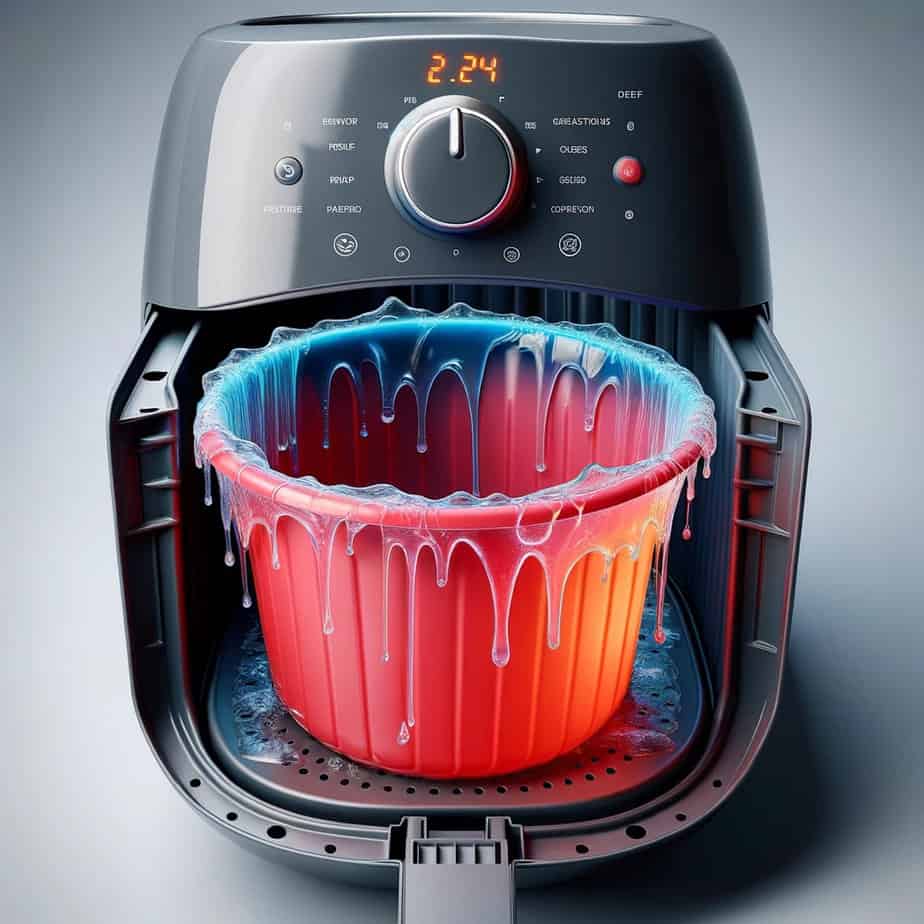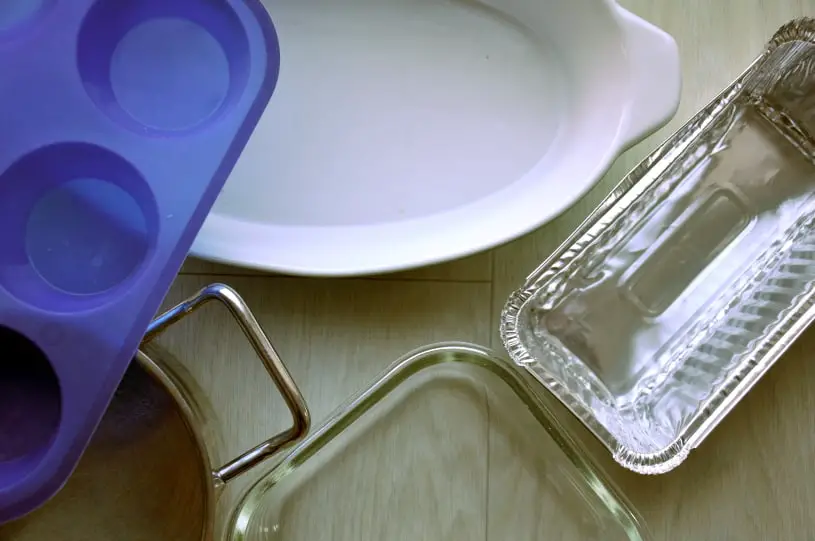[lwptoc]
Diving into the air fryer’s world opens up a realm of healthier, crispier cooking without the excess oil. But here’s the catch: the success of your air-fried culinary creations largely depends on the type of cookware you use.
You might wonder, “What dishes are safe to use in an air fryer?” I’ve explored various cookware options through trial and error, and I’m here to share those insights with you. In this guide, we’ll uncover the mysteries of air fryer-safe dishes, ensuring your meals are not only tasty but also prepared with safety in mind.
For those of you seeking quick information, all the safe and unsafe air fryer dishes are conveniently gathered in this table. This quick-reference guide will help you make informed choices, ensuring your air-fried dishes are not only delicious but also prepared safely.
Last update on 2024-08-11 / Affiliate links / Images from Amazon Product Advertising API
Types of Air Fryer Safe Dishes
When it comes to air fryers, not all dishes are created equal. Here’s a quick rundown of the types of dishes that are safe to use:
- Ceramic: Known for its heat tolerance and durability.
- Glass: Ensure it’s oven-safe to withstand high temperatures.
- Metal: Stainless steel and aluminum work well, but avoid using containers with non-stick coating.
- Silicone: Heat-resistant and flexible, making it a versatile choice.
- Paper: Parchment paper specifically designed for air fryers is available.
Here is a quick overview of all containers you can use in an air fryer:
| Type of Dish | Safe for Air Fryer (YES/NO) |
|---|---|
| Stainless Steel Dishes | YES |
| Metal Dishes (like Cast Iron) | YES |
| Oven-Safe Glassware | YES |
| Ceramic Dishes | YES |
| Silicone Containers | YES |
| Air Fryer-Safe Parchment Paper | YES |
| Aluminum Foil (for food wrapping) | YES |
| Plastic Containers | NO |
| Regular Paper Containers | NO |
| Non-Oven-Safe Glassware | NO |
| Non-Heat Resistant Ceramics | NO |
| Wooden or Bamboo Containers | NO |
| Containers with Painted/Decorative Elements | NO |
It’s important to choose dishes that can handle the high heat generated by air fryers, typically up to 400°F (204°C). Materials like ceramic and certain types of glass are excellent choices due to their heat-resistant properties. Metal dishes, particularly stainless steel and aluminum, are also great options, but be cautious with metal containers that have a non-stick coating, as they might release harmful fumes at high temperatures.
Silicone dishes are another safe bet. They are not only heat-resistant but also offer flexibility, making them ideal for a variety of recipes. Additionally, for those looking to prevent sticking or make cleanup easier, parchment paper made specifically for air fryers can be a handy accessory. However, it’s crucial to ensure that the paper is designed for air fryer use to avoid any fire hazards.
In the next segments, we’ll delve deeper into specific materials like glass, metal, and plastic, and discuss the suitability of using bowls in air fryers.
Can You Put Glass in an Air Fryer?

Yes, you can use glass in an air fryer, but it must be oven-safe. Oven-safe glass is designed to withstand high temperatures, typically up to about 450°F (232°C), which is within the operating range of most air fryers.
Key points to remember:
- Type of Glass: Ensure the glass is labeled oven-safe. Brands like Pyrex and Borosilicate are generally safe for air fryers.
- Temperature Changes: Gradual temperature changes are important. Don’t place glassware that’s been in a cold environment directly into a hot air fryer.
Always check for an oven-safe label on your glassware. If it’s not explicitly stated, it’s safer to opt for another type of dish. Using the appropriate glassware ensures safe cooking and prevents the risk of the glass cracking or shattering due to high heat.
Can You Put Metal in an Air Fryer?

Metal is generally safe for air fryers, but it’s important to know the right types and conditions for use:
Safe Metals to Use:
- Stainless Steel: Highly resistant to heat, making it ideal for air fryers.
- Aluminum: Good for wrapping food or lining dishes, but not for covering the air fryer’s base.
Conditions for Using Metal in Air Fryers:
- Avoid Non-Stick Coatings: Containers with non-stick coatings can release harmful fumes at high temperatures.
- No Plastic Parts: Ensure the metal dish doesn’t have plastic components, which can melt.
- Reactive Metals: Avoid copper and iron, which can react with acidic foods, altering flavor and color.
- Proper Placement: Never place aluminum foil at the bottom of the air fryer basket. This can obstruct airflow and lead to uneven cooking.
Using the right type of metal under these conditions ensures safe and efficient cooking in your air fryer.
Can You Put Plastic in an Air Fryer?

Using plastic in an air fryer is a definite no. Here’s why:
- Melting Point: Most plastics have a low melting point, far below the operating temperature of air fryers.
- Chemical Release: At high temperatures, plastic can release harmful chemicals into your food.
Air fryers typically operate at temperatures ranging from 300°F to 400°F (149°C to 204°C), well above the safe threshold for most plastics. Placing plastic in an air fryer risks melting the material, which can damage both your appliance and your meal. More importantly, heated plastic can leach chemicals into food, posing health risks.
Can You Put a Bowl in an Air Fryer?
Yes, you can put a bowl in an air fryer, but it depends on the bowl’s material. Here’s what to consider:
- Heat-Resistant Materials: Only use bowls made of oven-safe materials like ceramic, tempered glass, or metal.
- Size and Shape: Ensure the bowl fits comfortably in the air fryer basket and allows for proper air circulation.
- Avoid Plastic and Wood: Never use plastic or wooden bowls, as they can melt or catch fire.
The key is to use a bowl that won’t crack, melt, or release harmful substances when exposed to high heat. Materials like ceramic and tempered glass are ideal, as they can handle temperatures typically used in air fryers, up to about 400°F (204°C). Metal bowls are also suitable, provided they don’t have any non-metal parts or non-stick coatings.
What Containers Can You Not Put in an Air Fryer?
Certain materials are incompatible with the high-heat environment of air fryers. Using the wrong containers can lead not only to damaged cookware and appliances but also to potential health risks. Here’s a list of materials to avoid:
- Plastic Containers: Can melt and potentially release harmful chemicals.
- Paper Containers: Regular paper can ignite at high temperatures.
- Non-Oven-Safe Glassware: Risk of shattering under heat stress.
- Non-Heat Resistant Ceramic: Prone to cracking in high temperatures.
- Wooden or Bamboo Containers: Can scorch or catch fire.
- Containers with Painted or Decorative Elements: Risk of melting and chemical release.
Using the right container is not just about cooking efficiency; it’s about safety. To prevent damage to your air fryer and avoid health hazards, it’s crucial to avoid these materials.
Selecting the Ideal Dish for Peak Air Fryer Performance
Fine-tuning your choice of dish based on size, shape, and cleanup considerations can significantly enhance your air fryer experience. Let’s dive into these aspects:
Size: Tailoring Dish Size to Air Fryer Capacity
- Compact Air Fryers (2-3 Quarts): Opt for shallow dishes, roughly 6 inches (about 15 cm) in diameter, to fit snugly.
- Mid-Size Air Fryers (4-6 Quarts): Medium-sized dishes, approximately 7-8 inches (18-20 cm), offer a good balance.
- Large Air Fryers (6 Quarts and Up): Spacious models accommodate larger dishes or baking pans, up to 9 inches (23 cm), effectively.
The right dish size ensures optimal air circulation, which is essential for even cooking and achieving the desired crispiness.
Shape: Enhancing Air Flow with Dish Design
- Round Air Fryers: Round or oval dishes promote better airflow in these models.
- Square/Rectangular Air Fryers: Square or rectangular dishes fit well, enhancing uniform cooking.
The shape of the dish you select plays a vital role in airflow management within the air fryer. A well-matched dish shape can improve air circulation around the food, leading to more evenly cooked results.
Cleanup: Balancing Convenience and Safety
- Traditional Surfaces: Materials like stainless steel or glass might need more cleaning effort but are generally safer.
- Non-Stick Surfaces: Choose high-quality, PTFE/PFOA-free non-stick coatings. These surfaces simplify cleaning and are safe if certified for high temperatures.
While non-stick surfaces offer ease of cleaning, it’s crucial to select options that are safe for high-heat use and free from harmful chemicals.
Conclusion
In air frying, the right dish is as important as the recipe. Remember, not all cookware is air fryer-safe. Refer to the table provided for a quick guide on what to use and what to avoid. This ensures safe, effective, and delicious air frying every time.








